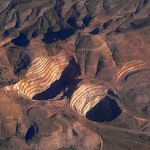“On Richness of Metaphor”
 When it comes to poetry, metaphor is cake to me, and music is icing. Personal details are sprinkles, and frankly I can do without them. The Furor Poeticus is a lit candle stuck in the cake. Or, in the best cases, a lit stick of dynamite.
When it comes to poetry, metaphor is cake to me, and music is icing. Personal details are sprinkles, and frankly I can do without them. The Furor Poeticus is a lit candle stuck in the cake. Or, in the best cases, a lit stick of dynamite.
There are poets out there who think of metaphor as an “ornament” to poetry. They go for lush descriptions. They go for hushed statements. They go for wry non sequiturs. My eyes glaze over when I read their work. It helps if they rhyme or scan or something, but even then I get bored. Tell me the hailstorm nails a coffin shut on summer’s green shroud, though, and suddenly my mind is a dachshund flushing out the badger of meaning.
I’ve noticed that the poets of my generation really love non sequiturs. Straight non sequiturs are easy. Metaphor is the non sequitur that means. English may be rhyme poor (so I am told; this has not been my experience in practice), but all languages are equally metaphor-rich. O my fellow poets: splurge!
—
On Richness of Metaphor
Its electronic funds transfer
embezzles the being
of a thing. Anything’s
isness is nothing
else’s business. Placing two
side by side, we steal
one from each. Or so
the honest spendthrift tongue
would teach. Call it like it is
and not like what it’s like.
Yet some of us believe
it’s revelation to bedevil
this with that. Confusion
releases at least
as much energy as fission.
We lay down traintrack
parallels perilously
deep in our interiors
and stripmine language for
metaphor or even more
fluorescent either
ores.
—
Amit Majmudar’s first book, 0°,0° [Zero Degrees, Zero Degrees], was released by Northwestern University Press / TriQuarterly Books in 2009. His second manuscript, Heaven and Earth, won the 2011 Donald Justice Award. His first novel, Partitions, was published by Henry Holt / Metropolitan in 2011. His second novel, The Abundance, will be released by Holt in early 2013.
—
Previously online: Amit Majmudar’s essay “The Tender-Hearted Hard Science.” Additional work appears in the Spring & Summer 2012 print edition of Poetry Northwest (v7.n1).
—
photo credit: J Mullhaupt via photo pin cc
